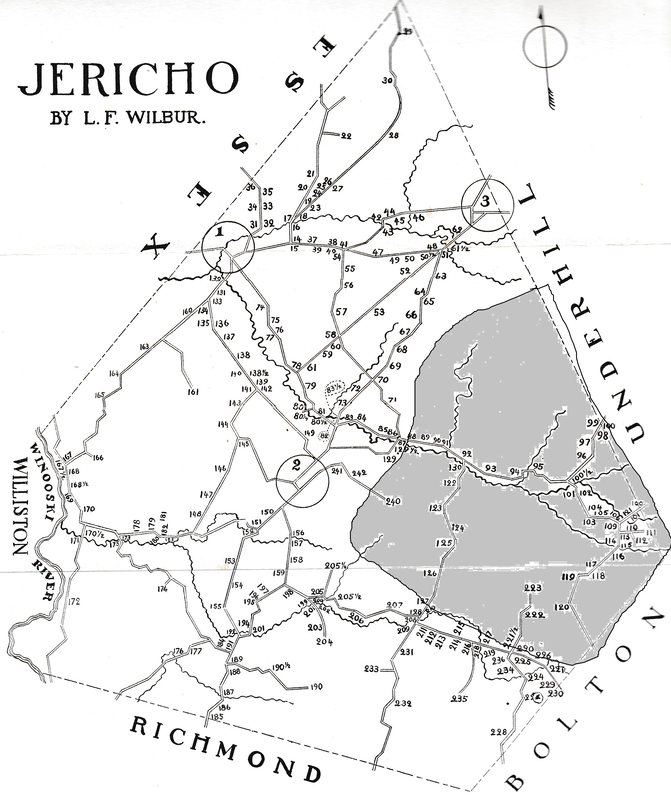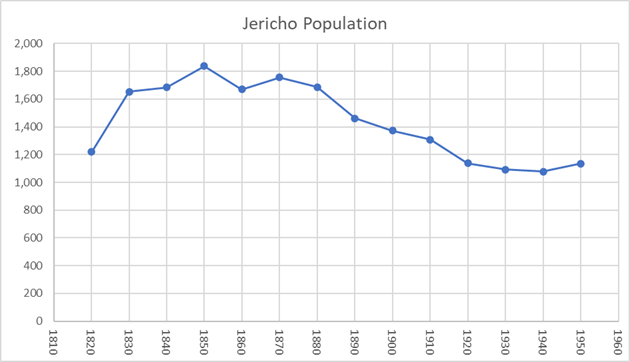Ethan Allen Firing Range - Where Did They Go?
by Terry Hook
In the 1920’s, the United States government procured land in Jericho for “Fort Ethan Allen, Vermont Artillery Range”. It is now known as the Ethan Allen Firing Range and is a Vermont National Guard post. It houses the Army Mountain Warfare School and the 86th Infantry Combat Team.
Between the time of the History of Jericho Volume 1 in 1913, and the publication of Volume 2 in 1963, nearly ¼ of the land area of Jericho and a large number of its farms was absorbed into what is now the Ethan Allen Firing Range. This process started in the 1920s and culminated in major acquisitions in 1941. The subsequent history of the range and the various military activities there has been documented in The History of Jericho Volume 3 in 2013. From this distant remove in time, I hesitate to call the 20-year-long event “cataclysmic” but the changes to the Town must have been significant. Volume 2 is, in my opinion, rather oddly silent about it. Perhaps the wound was still painful after only twenty years and much in the personal recollection of the authors of the volume. In the Introduction there is the rather pathetic sentence “The populace moved to surrounding communities.” I have often wondered if this were true – did many actually remain in Jericho, did most move to Essex or Richmond, or did many depart for more arable land in the west? I’ve tried to track the families that lived on what is now the Range, and where they ended up.
The maps in Volume 1 are a perfect fount of information. For every house, farm, and store extant at that time there is a list of the current and former owners. I counted 39 farms in the area later absorbed in the Range and have attempted to trace forward those owners. The Genealogies in the Histories are an invaluable resource, and I have also consulted census records and other genealogical resources. This could be just a start – there are more records to be found by burrowing at the Town Hall, and probably many more human stories than can be discerned from bare names and dates.
|
This map was made for the 1913 History. By the time that farms were being bought up by the Army in the 1920’s, some of these people were no longer with us, and three of the properties (Agan, Martin, and doncaster) were already noted as having been burned down.
The H.G. and R.M. Brown property is particularly interesting to me as I know from personal exploration that the barn foundation may easily be located by walking in from the end of Bolger Hill Road into the Range property. I believe that the entry refers to Haswell and Ray Brown, sons of George H. Brown, who was a son of Charles Brown, who was in turn the son of Joseph Brown of early Jericho fame. A confusing part is that Ray Brown’s “home farm” was on Stone Hill just outside of Jericho Center. I infer that the farm taken over by the Army was a second operation jointly owned and run by the Brown brothers. No mention of the loss of this farm is found in Volume 2, so it may not have been so significant to them or their only home and source of income. Ray Brown was married to Ora (also spelled Aura) Wilder, another well-known Jericho Center family, and their descendants remained in Jericho. Ray passed away in 1938, and Haswell in 1945. Haswell’s descendants went to Saint Albans and California. Some “moved away” and some “stayed put.”
Waite (sometimes spelled Wait) Bliss and his son Fred purchased the farm in 1915. Waite passed away in 1920, but Fred lived until 1977. In 1940 he and his wife Persis were living in South Hero, where he was a carpenter. It seems as if he was one of the “moved-aways.”
There is no other mention of “J. Downing” in Volume 1, nor in Volume 2. Another “moved-away?”
I believe that the “J. Laflin” refers to Jackson David Laflin, who lived in Jericho in 1930 and died at Fairfax in 1935. His son Milan married Ione Barber in Jericho in 1921. “Moved away.”
I’ve found no other entry or information on Howard J Murphy.
William Millham died in 1915. His son John Arthur (or just Arthur?) Millham appears to have lived in Richmond in 1940 and until his death in 1955. “Moved away.”
George Willard is easy to trace, not only was he prominent (he represented Jericho in Montpelier in 1904/1905) but his daughter Urania married farmer Arthur Pratt of Jericho and detailed the subsequent history of the Willard farms in Volume 2. The Willard farm was sold in 1921, and he purchased another, also on Lee River Road. That one was farmed by his son Armour from his death in 1927 until it was absorbed in the 1930’s. Armour moved to Williston and was a bus driver for Vermont Transit and died in 1962. This family was split – Urania stayed in Jericho and Armour “moved away.”
Frank Kinney’s story is also easy to find, as his son Earl detailed it in Volume 2. The Kinney farm was absorbed into the Range in 1940, one of the last. Frank and his wife Edna moved to Jericho Village near the old train station. He died in 1945 and Edna in 1962. Their granddaughter Nellie Labrie owned that house in 1963. The other Kinney descendants dispersed to Cambridge and Fletcher. It has been reported that the Kinney barn was disassembled and moved to the plot adjacent to what is now the Mills River Park.
Henry Morse died in 1928, and his wife Daisy in 1938. Of their four children, only Henry Ross Morse remained in Jericho. In 1940 he was listed as a carpenter. Of his four children one (Barbara Ann Morse) married Robert Bister and remained in Jericho.
Fred McGinnis died in 1954 and his wife Jennie died “at the home of Mr and Mrs Lawrence Tarbox” in Jericho Center in 1956. They had 11 (!) children, none of whom remained in Jericho.
Alpheus and Orlando were half-brothers. Their farm was reported to be among the first purchased by the Army. When Orlando passed away in 1921 he was living in Waterbury. Alpheus and his wife Grace removed to the Village of Jericho, where he did printing and clock repair until his death in 1943. Their daughter lived in Burlington.
I’ve found no other entry or information on Patrick McGrath.
I’ve found no other entry or information on Homer Boyer.
I have not located specific information about the ultimate fate of NP Gravell, but Volume 1 describes how his farm was virtually destroyed in a flood in 1914. At that time he was “well along in years” and perhaps he left town before the Range absorbed the farm. There may be some confusion with Gravelle Road but I do not believe it is the same family.
Ferris McGinnis was Fred’s brother, but he died young in 1915. Of his nine children none had stayed in Jericho, according to Volume 2.
Wm Cotey may have suffered the same fate as NP Gravell, as his farm was heavily damaged in 1914, and no further word has been found of him.
More information about J. Rokes has not been found. It is possibly the “Roakes” who lived near a sawmill close to West Bolton, but I have not uncovered more under that name either.
M. Guyette is something of a mystery also. There are several Guyettes mentioned in Volume 1: N., F., and W.C., but no other mention of an M. Guyette. There was a Carmen Guyette born in Jericho of Edward and Mae Guyette. As the Guyette name seems to have disappeared from Jericho, we likely have to characterize them as “went aways.”
I have not traced the specific manner in which AH Streeter is related to the current Streeters, but the family name lives on prominently in West Bolton and Jericho. Clearly a “stuck around.”
John McGee lived in the corner of Jericho near West Bolton. However, no specific mention of “Alexander H. McGee” is found other than the map. There was an Andrew H. McGee, father of John, in business there in 1888, so this may be a typographical error in Volume 1. As the McGee name appears to have disappeared I think that they are “went aways.”
In 1940 George Hall was a farmer living in Jericho. However, his father was Harlan P. Hall and he was only 33 at the time. This is not the same George Hall cited on the map. There was a George Hall descended from Asher Hall in Bolton, but he died in 1845. This particular George Hall remains a mystery.
The John Tarbox here is not of the same family as Cyrus Tarbox and what is now Tarbox Road. John Tarbox died in 1914 and his widow married Charles Nealy five years later. Harry was John’s son but it is not known if he took over the family farm. He was identified as a farmer in the 1940 census. Laurence (or Lawrence) was John’s grandson and was living in Jericho as of 1963. “Stayed around.”
Although E. S. Kingsley’s obvious trail ends, an Olive Kingsley of about the right age to be his wife was living in Jericho in 1940 and apparently widowed. Reported to have been living on a farm in 1935, which appears to have been in the vicinity of my own place (the Frank Brown farm). “Stayed around.”
I’ve found no other entry or information on Lewis Shortsleeve.
Fred Fuller died in 1936, and his wife Alice in 1937. They had ten children, two of whom stayed in Jericho – Frank, a painter, and Dewey, a farmer.
Edwin Flood moved to Jericho Center after his farm was absorbed in 1941. He worked for the Town. His daughter married William Trieb, son of B. Trieb, whose farm was also absorbed in 1941. “Stayed around.”
Waldo and Philemon Smith were brothers, and do not appear as of 1913 to have had wives or issue. Given the unusual names it is surprising that I have not traced them further.
Justin Brunnell (also spelled Brunnelle) died in 1934. There is no mention in Volume 2 as to the fate of his farm, but his family remained in Jericho or close by, one daughter marrying Alric Bentley and another Clarence Shiner.
Balthasar Trieb moved in with his daughter Anna Trieb Bentley after his farm was sold in 1941, until his death in 1943.
I have not found further reference to Mulford Savoy, despite it being a rather unusual name.
Despite being prominently remembered as the denizens of Nashville, the Nash name and descendants appear to have disappeared from Jericho; Thomas died in 1932 in Lisbon, New York.
Edward Sweeney ran the farm with his brother Michael until Edward’s death in 1934. Michael continued until 1941 when the farm was sold, at which time he and his wife moved to Essex Junction.
I roughly tabulate 22 “moved aways” and nine “stayed arounds” from the above list.
While the population did decline in those years from 1920 to 1940, the drop was insignificant compared to the loss in previous decades. Probably the biggest impact to the town was the loss of access to the land – the essay in the 1963 History was rather wistful about the early days of the Army’s presence, when the citizenry was welcome to come and watch the cannons.
Sources:
- Jericho, Vt. Historical Committee. The History of Jericho, Vermont. Chauncey H. Hayden, et al. (eds.). United States: Free Press printing Company, printers, 1916.
- The History of Jericho, Vermont, Volume 2. Chauncey Hoyt Hayden and Elinor Irene Schillhammer Merle (eds.) United States: Fine Press Printing Company, 1963

